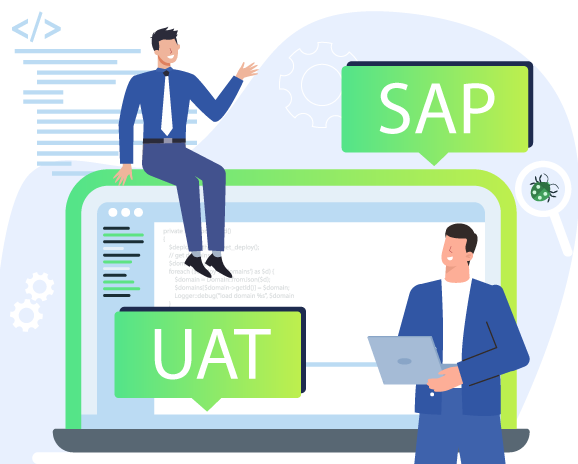The Great Resignation: Delivering Exceptional Customer Experiences with Test Automation

Why Does User Experience Matter?
In our last blog on the Great Resignation, we covered the implications of time to market for businesses and how test automation can best address test ecosystem bottlenecks and assist businesses in launching flawless, smart, and secure web and mobile applications.
As per our last blog discussing the Great Resignation and time to market, businesses often find themselves compromising user experience for the sake of hasty deployment schedules or looming release dates. In this blog, we will be guiding the readers to better understand the implications of user experience (UX) and how ensuring top-notch UX has the potential to make or break a business’s growth trajectory.
How User Interaction Dictates Customer Engagement and Retention
Let’s put ourselves in a customer scenario. Imagine you are attempting to load an application and it takes longer than 3 seconds. As per studies done by Google, over 53% of users would have already left to seek out the next relevant web page. Beyond just load time delays there are bugs, errors, and application inconsistencies which directly affect whether a user is satisfied with their experience. This is another alarming example of how user experience can impact a business’s visibility and affinity.
Regardless of application aesthetic, functionality, or feature richness, application success is highly governed by end-user response. Given the shifting attention spans of users, providing a high-quality, positive experience has never been more essential. With application requirements spanning multiple platforms, browsers, and devices, releasing applications on time surely has its perks. However, maintaining end-to-end user experience can be a factor that makes or breaks application success.
Let’s learn why businesses need to make the user experience of their application the number one priority.
Creating Brand Differentiation
High quality user experience assists in customer retention and brand recognition. Differentiating your brand is vital as customer experience slowly becomes more important than product or price. Quality UX (User Experience) helps you build trust amongst your users, who can depend on your product to consistently deliver.
Great UX backed by robust performance, functionality, and load testing is essential for today’s enterprises to not only sustain but succeed in the ever-competitive application market landscape. Mapping out each of these factors is essential to enhance the user experience:
- Adaptability. Responsive design for web and mobile applications should be leveraged so that you can ensure proper application functionality regardless of the device your audience uses.
- Design. The attention-grabbing, aesthetic design of any web and mobile application plays an important role in UX. While your development and QA teams are striving to ensure functional performances, let your UX design team develop engaging front-ends.
- Functionality. Whether it’s a button or a link, every element within your web and mobile application should work as expected and have a purpose.
- Navigation. Great UX facilitates site navigation that helps your users easily identify what they are looking for rather than having to click multiple links or search endlessly.
- Usability. Your application’s structure should be catered to your user’s needs long before they even know they need something.
- Value. Your application’s design should clearly communicate the value of the service or product.
Testing your application from all the above prospects by leveraging automation can help enterprises succeed.
Fostering User Retention
Customer acquisition, engagement, and retention have always been primary objectives for enterprises. All of these can be ensured by implementing great UX strategies which have a positive impact on customer loyalty. A web and mobile application that’s user-centric, reliable, intuitive, smart, and provides value for your audience can help foster trust and reliability to keep your audience returning for more. Some things you can do to keep your application user-oriented include:
- Ensuring ease of use across the platform. Performing basic, everyday actions should be simple and streamlined.
- Creating and maintaining documentation. Having up-to-date information about the application and its functionality can make it or break it when it comes to user retention.
- Implementing customer feedback. Whether it’s through a survey or a one-on-one discussion, ensuring that you have an avenue for critical feedback and a system in place to implement those suggestions is vital to keeping customers using the application.
- Starting a customer education program. Whether it’s through demos, videos, or implementing some kind of online university/learning platform, giving an avenue for users to learn the intricacies of the application will help greatly.
Keep Your Audience on Your Application Longer
If it’s too challenging to navigate a site or an application, your audience will flock to the competition to find what they need. But, with good UX ensured by superior UX testing, you can improve bounce rates and keep users on your application longer. Thus, it’s key to ensure great UX that simplifies common tasks and keeps users engaged with the application.
The Way Forward
We’re embarking on a future driven by automation. As per reports, by 2029, computers are likely to be more intelligent than humans. Artificial intelligence (AI) and machine learning (ML) are ensuring high levels of synchronization between human and machine intelligence. They are opening new avenues for designers to create personalized, intricate user experiences capable of satisfying an individual user’s needs. On top of that, AI/ML can help reduce time and effort by assisting designers in crafting and maintaining customer services and allowing them to receive fast and quality feedback on designs.
As automation has paved its way into every aspect of our lives, it is anticipated to play a pivotal role in the future of UX for applications as well. Automation may be the next big thing to impact the entire industry of UX design, which will ultimately influence product or application development. Automation can be a catalyst in creating compelling products with business-driven yet customer-centric testing and development strategies.
The Great Resignation and Its Impact on User Experience
You might think of the Great Resignation as being more about employee experience rather than user experience. Here are some interesting insights:
- Employees are the biggest assets any organization has with them as they are critical in ensuring organizational short, and long-term vision, and objectives. The same is applicable for organizations in the testing sphere too. These enterprises need their in-house pool of QA resources to ensure better testing and development synchrony which is essential for ensuring the product or application hits the market on time in all its features, and glory.
- It is evident that the need for testing efficiency and scalability has been following an upward trend. While the future may seem promising, testing professionals will have a broader learning curve. Enterprises need to adopt a strategic approach when it comes to equipping their in-house QA resources with the latest AI, ML, and automation knowledge base.
- From an alternate perspective, with test automation being in trend and demand, the growth opportunities are massive. Enterprises might have to work hard to retain their best testing talent and this can get cost-intensive.
All of the insights listed above are going to influence the enterprise’s testing and application development processes, workflows, and timelines. And, even though the products might launch on time, without robust testing, the user experience of the application is at substantial risk.
While the Great Resignation may last beyond 2022 and the post-pandemic period, how do enterprises ensure top-notch user experience of their mobile and web applications? Qyrus, a simple, smart, secure, and scalable test automation platform seems the best possible game plan.
General benefits of Qyrus are well known:
- Simple test building
- Scalable infrastructure
- Smart AI/ML tools to enable testing
- Expansive test case coverage
- Test management and test data management features
- Advanced reporting, analytics & insights
Though these benefits are expansive, test automation can play a pivotal role in crafting, streamlining, and enhancing an application’s user experience. Let’s learn how Qyrus can assist enterprises in their quest for contextual and consistent user experience.
Delivering Customer-Centric Applications with Qyrus
During the pandemic, remote work and support caused extreme dependence on web and mobile applications for otherwise offline and routine tasks. And, without test automation, launching flawless applications on time and at scale will be more difficult.
Qyrus is a one-of-its-kind, and truly low-code/no-code test automation platform that leverages advanced AI/ML capabilities to offer greater testing efficiency. It allows users to easily maintain application quality and user experience.
With its visual testing, rich test reporting, and comprehensive testing specifications, Qyrus enables enterprises to simulate user journeys and establish proper functionality for enhanced customer experience. Qyrus offers:
- Recorders for real devices and local browsers (interact directly with your application while testing mirroring and maintaining common user interactions)
- Screenshot & Video Reporting (watch the test run – and screenshots to note step by step what a user sees across their journey)
- Rover (exploratory robot that will autonomously traverse mobile applications using reinforcement learning models trained with over 80,000+ hours of humans interacting with mobile applications)
Enterprises can enable a shift-left approach and hold an aggressive position in the market centered around an amazing customer experience validated through automated testing with Qyrus. Keeping a leg up over the competition has never been more important!
How Can Qyrus Help You Make Your Automation Testing Endeavor Cost-Efficient?
So far in our blogs around the theme of great resignation, we have highlighted how test automation can address time to market, often influenced by skilled resource gaps and customer experience. Now, the question is, can enterprises keep their application development and testing endeavors truly cost, and resource-efficient? How is automation going to be a deciding factor, and how can Qyrus help?






